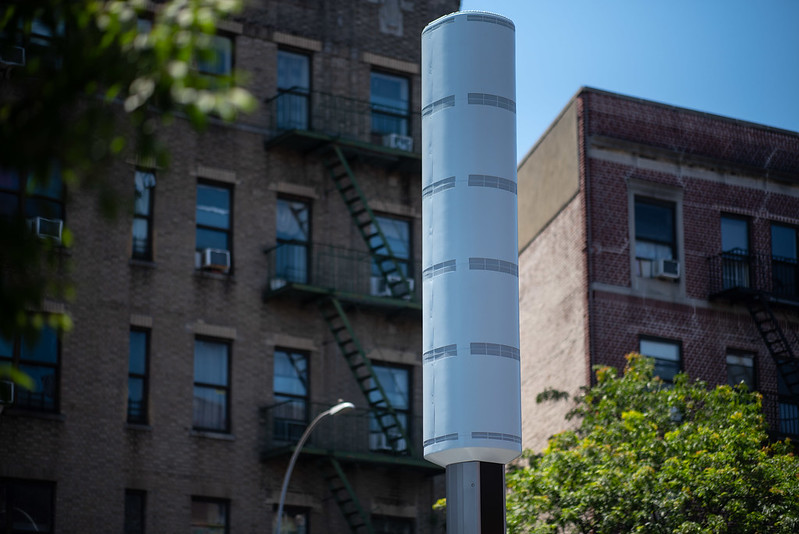
A 5G tower (photo: Michael Appleton/Mayoral Photography Office)
If you have walked around New York lately, you may have noticed a new addition to the streetscape: 32-feet-tall 5G towers looming over city sidewalks. As expected, these towers have inspired a range of colorful descriptions from New Yorkers for their uninspired design and massive size. From Washington Heights to Carnegie Hill, everyone seems to be raising the same questions and concerns about the design and placement of the 5G towers.
The city’s goal of expanding 5G communications is both laudable and necessary; in the new hybrid world of remote meetings and online work, access to high-speed internet is essential. The 5G towers, which are operated by a consortium named CityBridge, are supposed to be part of the solution by bringing complete connectivity to all parts of the city. To achieve this important goal, nearly 2,000 5G towers are to be installed citywide.
As representatives for the communities receiving the first rollout, we can attest that the process has not been a success -- with a failure to provide essential data about siting locations, insufficient community engagement, and a negligence of the appropriate federal siting approval processes.
For instance, a very common and reasonable request is for the city to explain why a certain location or block was chosen. CityBridge claims that network carriers, like AT&T, Verizon, and T-mobile, have shared coverage gaps with them and that determines where the towers go. However, to date, they have failed to share this data with elected officials or the public.
This lack of information leads many New Yorkers to rightfully question if this new arrangement is an effort to drive more revenue rather than the altruistic goal of expanding service to the most necessary and desirable locations.
Furthermore, the design of these towers leaves much to be desired, especially when placed near historic districts and landmarked buildings. Greater efforts should be made to ensure the design matches the surrounding area. We can also approach the towers as a creative opportunity by allowing artists to add a splash of color, much like the MTA partners with artists and poets to enhance the subway. Doing so could transform towers into local landmarks as opposed to dull, unappealing poles on the sidewalk.
Considering the issues raised, we believe that the towers – where truly necessary -- should be installed in a more deliberate, transparent manner that provides an opportunity for people near potential sites to have a say in the siting process while accessing the necessary data to back up the choice of location.
This week, the New York City Council’s Committee on Technology will hold an oversight hearing on the rollout of the 5G towers to explore these questions and more. The hearing will be an opportunity to hear from technology experts, community groups, and CityBridge. It will hopefully shed light on what is truly guiding the placement of these towers and where they are needed.
The hearing will also allow us to better understand how 102 towers were installed without going through the appropriate FCC review processes. In an April 20 letter, the FCC determined that CityBridge had not gone through the required historic preservation and environmental reviews as mandated under the National Historic Preservation Act and National Environmental Policy Act, respectively. The letter also ordered that the 102 towers already installed be subject to a “post construction review.”
The rollout of citywide 5G represents an opportunity to bridge the digital divide and ensure every New Yorker has online access. However, crucial questions must be answered to determine if the current approach is the best way to go about it. An opaque, top-down process understandably invites suspicion and controversy, and it is time to bring the public to the table. At the end of the day, these towers are installed in public space and the public has a right to be a part of the process.
***
City Council Members Keith Powers and Carmen De La Rosa each represent parts of Manhattan. On Twitter @KeithPowersNYC and @CnDelarosa.
***
Have an op-ed idea or submission for Gotham Gazette? Email This email address is being protected from spambots. You need JavaScript enabled to view it.




